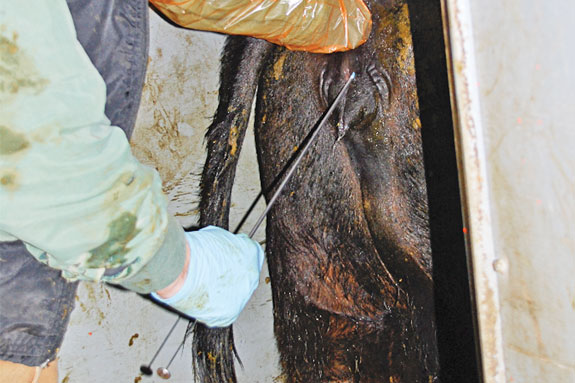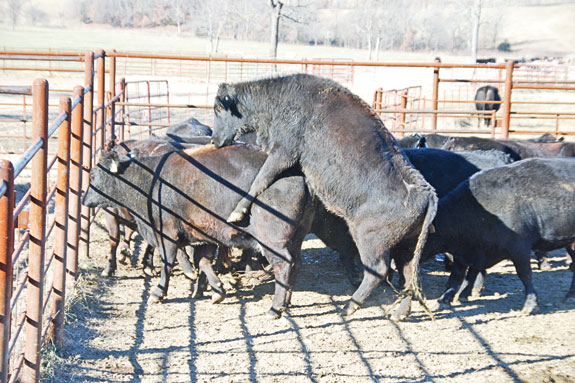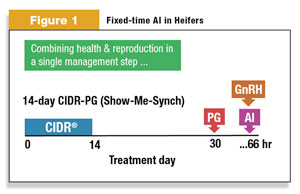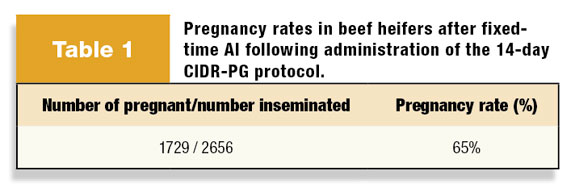“We’re breeding by appointment, so we know when we’re going to be breeding. We can have plenty of help,” Sauls explains.
With a little more than 200 head in all, the Sauls are so sold on the timed AI breeding program that they sunk all 175 head of their fall calvers into it last November and December.
“It’s such a time-saver over having to do heat detection twice a day,” Sauls maintains.
 Consider timed AI
Consider timed AI
According to Dr. David Patterson, University of Missouri Extension state beef specialist, approval in the U.S. of the CIDR®, a vaginal implant progestin-based product, has given cattlemen more precise control when it comes to manipulating estrous cycles in cattle.
In essence, “fixed-time AI” is breeding by appointment without detecting heat.
Use of timed AI is on the rise, especially in Missouri, Patterson says, because of two primary reasons. “We’re the ‘Show Me State.’ If producers try it and it works well for them, then they tend to become believers,” he explains.
The other reason is due to the time and labor savings through timed AI, Patterson says.
“In Missouri, we’re also emphasizing in the timed AI trials we’re doing that it’s important to make good sire selection decisions,” Patterson notes. “Especially in the commercial sector, it’s very important that producers consider the use of high-accuracy or highly proven sires.”
And Sauls is one of those commercial producers who see value in mating his females to the best bulls he can afford. “If I’m going to go through the work, I want to go ahead and spend a little extra money and use the higher-accuracy bulls available,” Sauls says.

Build success in heifers
Timed AI has had success in both dairy and beef cows. Results in beef heifers, though, have been inconsistent.
According to Patterson, in the past, the MGA prostaglandin protocol was used most extensively to synchronize estrous cycles in beef heifers. Once CIDRs were cleared for use, Patterson says there was interest in comparing a longer-term CIDR protocol in heifers similar to the MGA protocol to determine how it would perform in a timed AI setting.
Funding secured through USDA’s National Research Initiative Competitive Grants Program in Animal Reproduction allowed Patterson to conduct research on heifers in Missouri using timed AI.
“Recent work has given us the opportunity to make some really precise comparisons among protocols,” Patterson explains.
Through a collaborative effort with Genex Cooperative, data were collected on 2,656 heifers in three states, including Missouri. The research focused on the development of a long-term EAZI-BREED™ CIDR®-based protocol in beef heifers that may be used to facilitate fixed time AI.
The 14-day CIDR-PG protocol, referred to as Show-Me-Synch in Missouri, is outlined below and is the outcome of the research effort.

Figure 1 illustrates an example of how the protocol works. A CIDR is implanted on a Monday. Fourteen days later, on a Monday, the CIDRs come out. Then 16 days later, prostaglandin is administered via intramuscular injection to bring the heifers into heat.
All heifers are then inseminated 66 hours after the injection of prostaglandin. Each heifer also receives an injection of GnRH at the time of insemination, which is used to induce ovulation.
Using timed AI, Patterson reports an average pregnancy rate of 65 percent using the protocol on the 2,656 heifers mentioned above.
Patterson is especially fond of the protocol because it is simple and because it affords producers and their veterinarians an opportunity to combine herd health and CIDR administration. Pre-breeding booster vaccinations may be given at the time the CIDR is inserted. Ultimately, this reduces animal handling and helps with effective management of both health and reproduction.
“From start to finish, it’s about a 33-day protocol,” Patterson says, adding, “but that is probably advantageous for heifers because they are at such varying stages of reproductive development for maturity.”
Genex Cooperative area sales manager Stan Lock adds, “One of the main points we see is that synchronization and timed AI of young animals really sets them up for success for their whole life. Heifers are calving early in the season, which is so important to profitability.”
Lock points out that it takes proper planning ahead of time, especially on a protocol that is as lengthy as the 14-day program, because it has to be initiated more than a month in advance of the planned breeding date.
He goes on to note that herd health, nutrition and proper facilities also play a critical role in making timed AI protocols work in both heifers and cows.
Timed AI, according to Lock, can greatly reduce the need for natural service or clean-up sires. “Most producers realize they won’t have to purchase as many sires for that purpose, but in turn it enables them to purchase sires of a higher genetic value,” he states, adding that producers get more uniformity in their calf crop by getting more females bred the first day of the breeding season.
“Basically,” Lock explains, “timed AI provides cattlemen three opportunities to get females pregnant in a 45-day period, where otherwise they would only get two.”

Save time to save money
Savings through timed AI become a big issue, Patterson says, if producers consider labor as part of the overall equation, especially when heat detection is involved.
Patterson notes that cattlemen need to understand that when using timed AI, virtually every cow in the herd is going to get inseminated. From the hormone injections to semen cost, timed AI is a big commitment. “There’s a big step in going from observing heats naturally to going to a timed AI setup,” Patterson explains.
“Paying attention to detail becomes even more critical,” he continues. “Paying attention to the clock is even more critical.”
Patterson maintains that results in traditional AI breeding programs are dependent on the level of heat expression and the cattlemen’s ability to accurately detect heat. “In timed AI, though, you take control of the whole system,” he says.
Patterson encourages producers to seek out the assistance of professional AI companies. Skilled technicians can really deliver, he notes.
The savings in labor are well worth considering timed AI, according to Sauls. He says it’s important to know that once you start the timed AI process, you are committed. “So, you have to deal with the weather, whatever you get, on breeding day. That can sometimes be a challenge for the fall calving season.”
Concentrate the breeding season
Patterson points out that there is some variability in how sires perform in timed AI settings. And that may be one of the next big areas in improving results from timed AI programs.
From a reproduction standpoint, though, Patterson says being able to concentrate the breeding season by using timed AI – whether the cows calve as a result of AI or not – is really an important factor for producers to consider.
“Producers who have never done this before tend to overlook how they will begin over time to see improvements in overall reproductive performance,” Patterson notes. “More cows calving early translates to a greater time for cows to recover following calving. Cows then go into a breeding season having higher cycling rates and the whole process builds on it.”
The end result: Patterson says producers are able to make faster genetic improvements in their herds.
For producers such as Sauls, a concentrated breeding season means a concentrated calving season. And that means a more uniform end product.
As he puts it, “Timed AI is the only way to go.” ![]()
Author’s Note: Learn more at the Applied Reproductive Strategies in Beef Cattle Conference, Aug. 31-Sept. 1, 2011 in Joplin, Mo. For more information, contact Dr. David Patterson at 573-882-7519 or email: PattersonD@missouri.edu
PHOTOS
Top: Dale Sauls of the Rocking Z Ranch in southern Missouri uses fixed-time AI for its time savings in heat detection. He also favors proven bulls with high-accuracy EPDs selected for marbling and ribeye.
Middle: Time savings in heat detection is a key reason producers are incorporating “fixed-time AI” into their operations.
Bottom: According to Stan Lock, area sales manager for Genex Cooperative, timed AI can greatly reduce the number of natural service or clean-up sires a producer needs in his operation. In turn, that enables the cattleman to purchase sires of a higher genetic value.
Photos by Show Me Agri-Comm.







